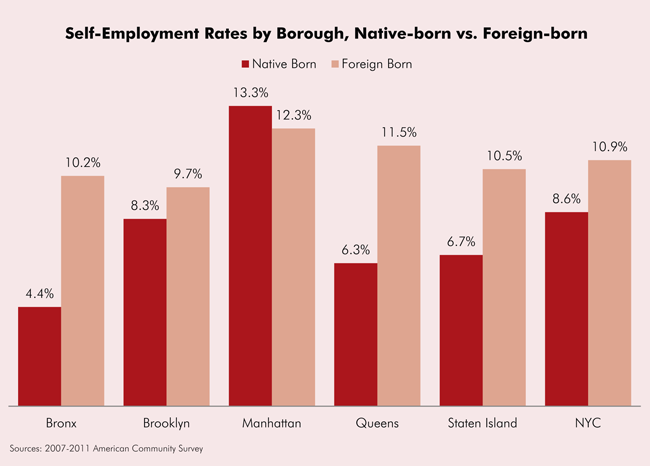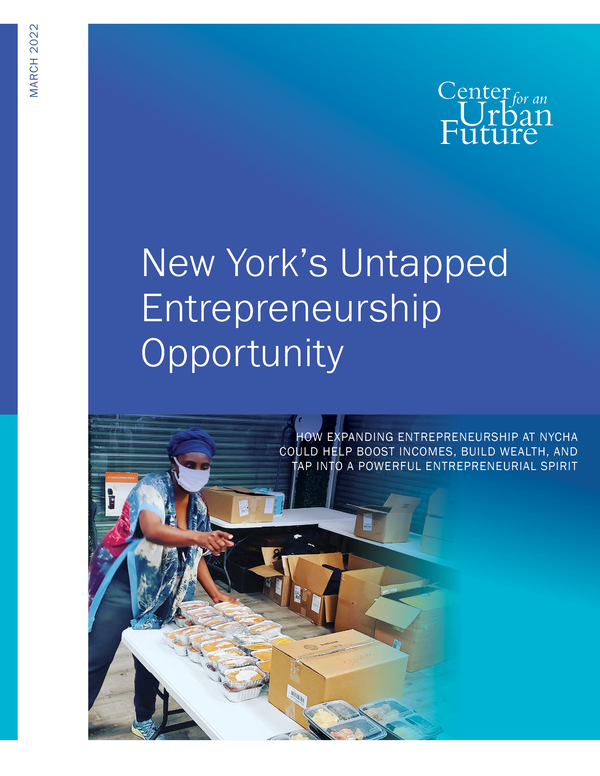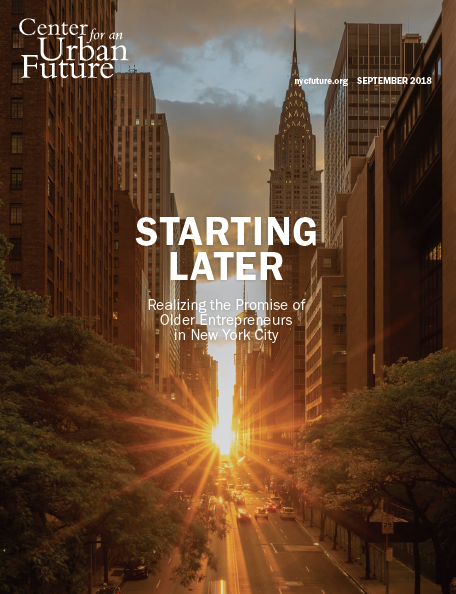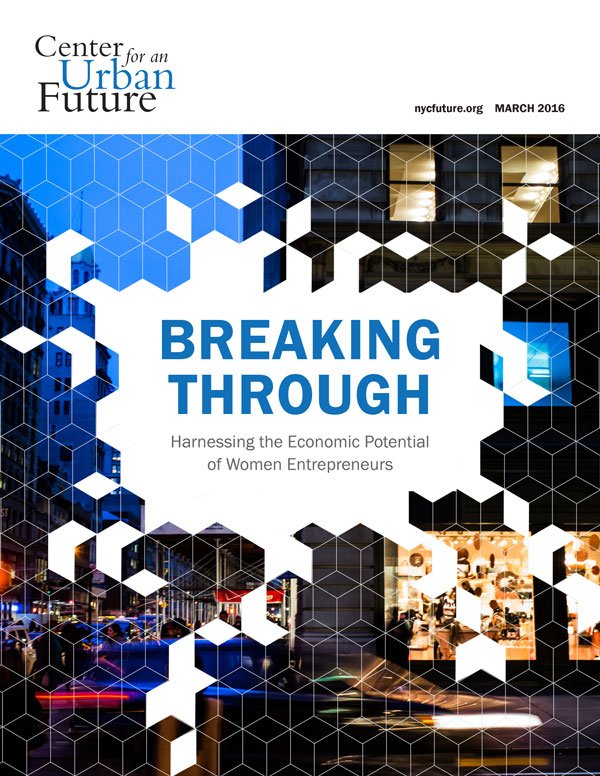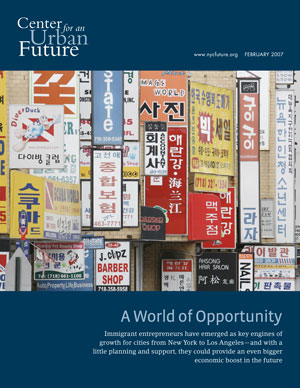The following is the introduction to Launching Low-Income Entrepreneurs. Click here to read the full report (PDF).
New York City is now in the midst of a new golden age of entrepreneurship. In recent years, mid-career investment bankers, lawyers and media professionals have bounced back from layoffs by striking out on their own, opening everything from food trucks and restaurants to digital marketing agencies. Twenty-something college grads facing the worst job market in decades have turned to entrepreneurship in droves, establishing Internet startups, design firms and countless other new ventures. And immigrants from Washington Heights to Sheepshead Bay have continued to open food carts, franchises and other businesses at a rapid clip.
One would think that recent economic conditions—not only an extremely high jobless rate, but a changing economy offering few middle-income jobs for individuals without a bachelor’s degree—would also prompt a significant uptick in the number of native-born New Yorkers from low-income backgrounds who see entrepreneurship as a pathway out of poverty. However, this does not appear to be the case.
Interviews we conducted for this report with small business experts, microfinance groups, entrepreneurs and community leaders suggest that low-income New Yorkers who were born in the United States are starting businesses at a fairly low rate. Our analysis of self-employment rates in neighborhoods across the five boroughs confirms this. Each of the 10 ZIP codes in the city with the lowest rates of self-employment have median incomes below $33,000, and in all but one the share of the population that is native-born exceeds the city average. In contrast, neighborhoods with similarly low median incomes where most residents are foreign-born have higher-than-average rates of entrepreneurship. Meanwhile, native-born New Yorkers who live in affluent neighborhoods have among the highest rates of self-employment in the city.
Given how much capital it takes to start a business, and how much risk is involved, it is hardly surprising that many asset-poor New Yorkers have shied away from entrepreneurship. However, at a time when so many newly created jobs offer low wages and limited opportunity for economic mobility, it is time for policymakers, economic development officials and workforce development professionals to embrace entrepreneurship as one route for low-income New Yorkers to achieve economic self-sufficiency.
This report concludes that it is eminently possible to expand the number of low-income entrepreneurs in New York. As this report documents, while relatively few low-income minorities are starting formal businesses, there is no lack of entrepreneurial spirit or creativity among the native-born poor—and many earn money from “side-hustles.” Ample evidence suggests that a more strategic focus on promoting, teaching and supporting entrepreneurship in New York and other cities could have a big impact.
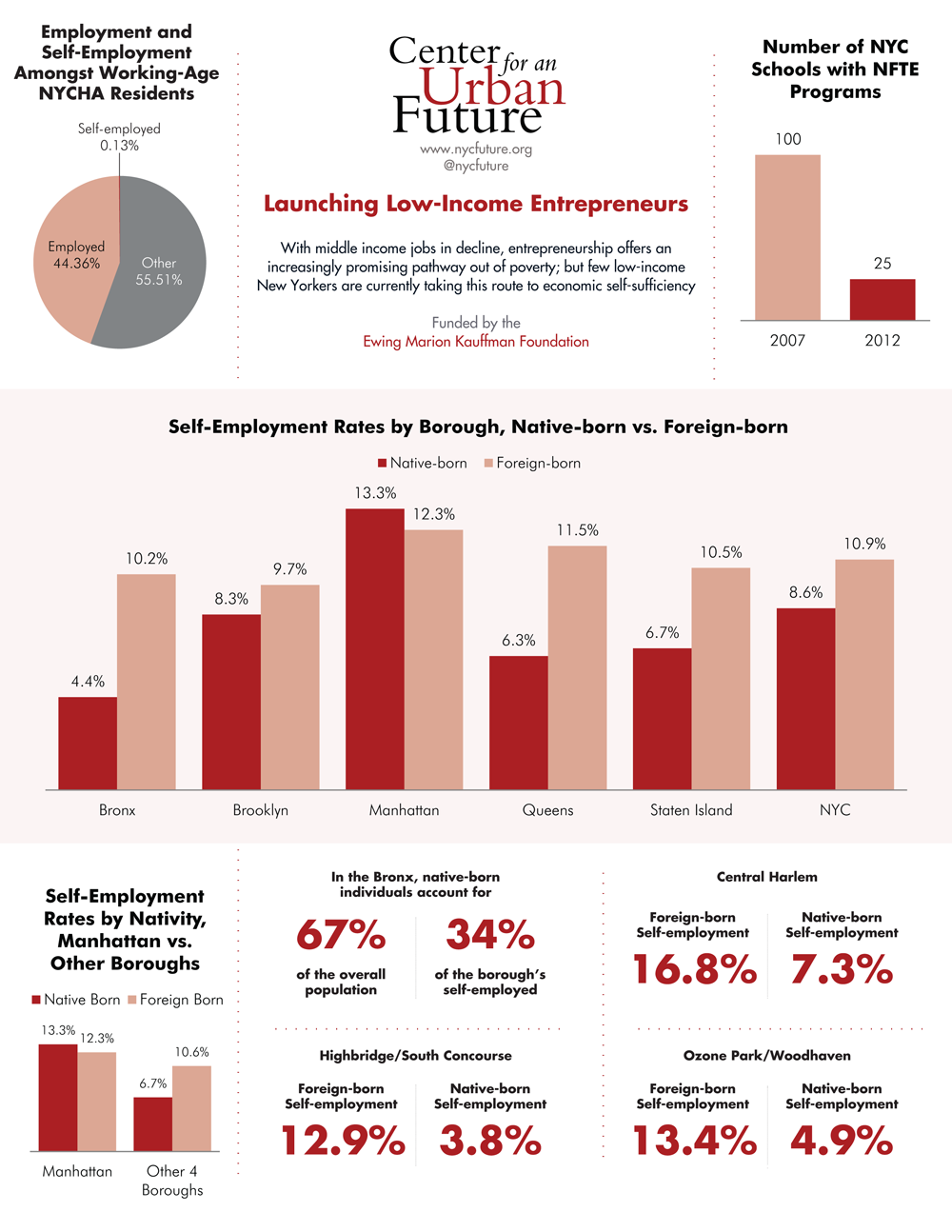
This report provides the most comprehensive examination of low-income entrepreneurship in New York. Funded by the Ewing Marion Kauffman Foundation, the report documents current self-employment rates among low-income people (both native-born and foreign-born), details the obstacles that keep larger numbers of native-born individuals from starting businesses and assesses how entrepreneurship among low-income individuals is currently encouraged and supported in New York. The study also features a snapshot of programs in other cities and states that effectively promote and support low-income entrepreneurship. The report is based on an extensive data analysis and interviews with more than 75 entrepreneurs, small business and microfinance experts, community development leaders, workforce development practitioners, economic development officials and educators—both in New York City and around the nation.
Entrepreneurship has been a proven ticket to financial empowerment and economic mobility for countless immigrants—a fact that the Center documented in our 2007 report, “A World of Opportunity.” In that study, we showed that massive numbers of immigrants in New York, Boston, Houston and Los Angeles have turned to entrepreneurship and in doing so have transformed neighborhoods as well as their own economic fortunes. Some of these entrepreneurs have been wildly successful, generating numerous jobs for their communities and significant financial rewards for themselves. Many others simply make enough to live on. Most turned to entrepreneurship in the first place because they saw it as the quickest and most logical path for them to provide for their families.
But while so many immigrants—including newcomers who are both poor and poorly educated—have turned to entrepreneurship, many fewer native-born poor people have done so.
Citywide, the native-born self-employment rate is 8.6 percent, which is considerably lower than the foreign-born self-employment rate of 10.9 percent. But even this modest rate is inflated because it includes affluent native-born entrepreneurs, particularly in Manhattan and Brooklyn. For example, in Manhattan, roughly 97,000 native-born residents—or 13.3 percent of the working-age native born population—are self-employed, compared to only 124,000 (or just 6.7percent) in the other four boroughs combined.
In the Bronx, Queens and Staten Island, the native-born self-employment rate is roughly half that of the foreign-born self-employment rate. In the Bronx, where working-age residents tend to be poorer and less educated than people in the rest of the city and nation, only 17,000 native-born residents (4.4 percent of the total) have started their own incorporated or unincorporated businesses, compared to 33,000 foreign-born residents (10.2 percent). In Queens, where nearly 48 percent of residents are foreign-born, 35,700 or 6.3 percent of native-born residents are business owners while nearly 90,000 or 11.5 percent of immigrants are. In Staten Island, 6.7 percent of native-born residents are self-employed, compared to 10.5 percent of immigrants.
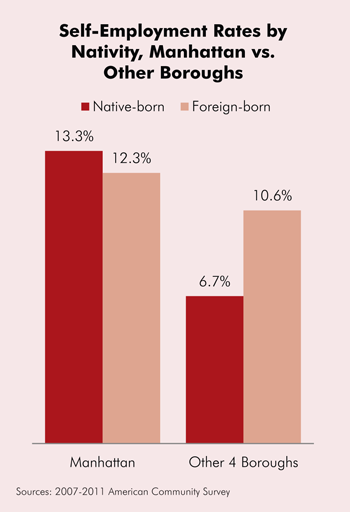
Similar trends are apparent within individual low-income neighborhoods. For instance, in the Highbridge/South Concourse section of the Bronx, the native-born self-employment rate (3.8 percent) is less than a third the foreign born self-employment rate (12.9 percent). Meanwhile, the native-born self-employment rate is less than half the foreign-born self-employment rate in several other disadvantaged communities, such as Central Harlem (7.3 percent native-born vs. 16.8 percent foreign-born), Jamaica (3.6 percent vs. 9.2 percent), Morissania/Belmont (4.1 percent vs. 11.5 percent) and Ozone Park/Woodhaven (4.9 percent vs. 13.4 percent).4
Overall, there is a remarkably strong correlation between self-employment, median income and place of birth at the neighborhood level. This was apparent when we examined self-employment rates in the city’s 55 Census-defined neighborhoods. We divided the 55 neighborhoods into three groups—a bottom third, representing the 18 neighborhoods with the lowest rates of self-employment; a middle third featuring the 18 neighborhoods with the next highest rates of self-employment; and a top third of the 19 neighborhoods with the highest self-employment rates in the city.
The bottom third—18 neighborhoods with self-employment rates between 3.9 percent and 7.4 percent—are both poorer than the rest of the city and have a disproportionate share of native-born residents.5 Averaged together, the 18 neighborhoods with the lowest self-employment rates have a median income of $25,150, a foreign-born share of 32.2 percent and a 6.1 percent self-employment rate. For example, Brownsville/Ocean Hill has a 4.5 percent self-employment rate, a median annual income of $19,900 and a 72 percent native-born population. The Soundview/Parkchester area of the Bronx has a 5.6 percent self-employment rate, a median annual income of $22,700 and a population that is 70 percent native born. Additionally, East New York, Co-op City, the Rockaways, Morrisania, Bed-Stuy, East Harlem, Mott Haven and Staten Island’s North Shore all have higher than average proportions of native-born residents, low median incomes and among the lowest self-employment rates in the city.
In comparison, the middle third—18 neighborhoods with self-employment rates between 7.4 percent and 9.8 percent—actually had lower median annual incomes than the bottom third ($23,718, on average) but much higher levels of foreign-born residents. In all but two of these 18 neighborhoods, the share of the population that is foreign-born exceeds the citywide average (36.8 percent). For instance, in Jackson Heights, where 63 percent of residents are foreign-born, the median annual income is $22,900, but the self-employment rate is 9.6 percent. In University Heights/Fordham (40 percent foreign-born), the median income is just $14,811 but the self-employment rate is 9.3 percent. Other neighborhoods with median incomes below $25,000 but fairly high rates of self-employment include Elmhurst/Corona (9.3 percent), Sunset Park (9.1 percent) and Bensonhurst (9.0 percent).
The native-born residents who are turning to entrepreneurship in greater numbers have more financial resources. Greenwich Village, the Upper West Side, the Upper East Side and Turtle Bay all have some of the highest self-employment rates in the city and are also among New York’s wealthiest neighborhoods, with median annual incomes of between $59,600 and $70,700. Brooklyn’s Park Slope, Carroll Gardens and Brooklyn Heights—with self-employment rates of 12.3 percent and higher—all have lower median annual incomes than the top neighborhoods in Manhattan, but they are still higher than average, and residents have much higher levels of educational attainment. (Overall, the 19 neighborhoods with highest self-employment rates have an average median income of $38,583, a foreign-born share of 32.5 percent and a self-employment rate of 12.6 percent.)
